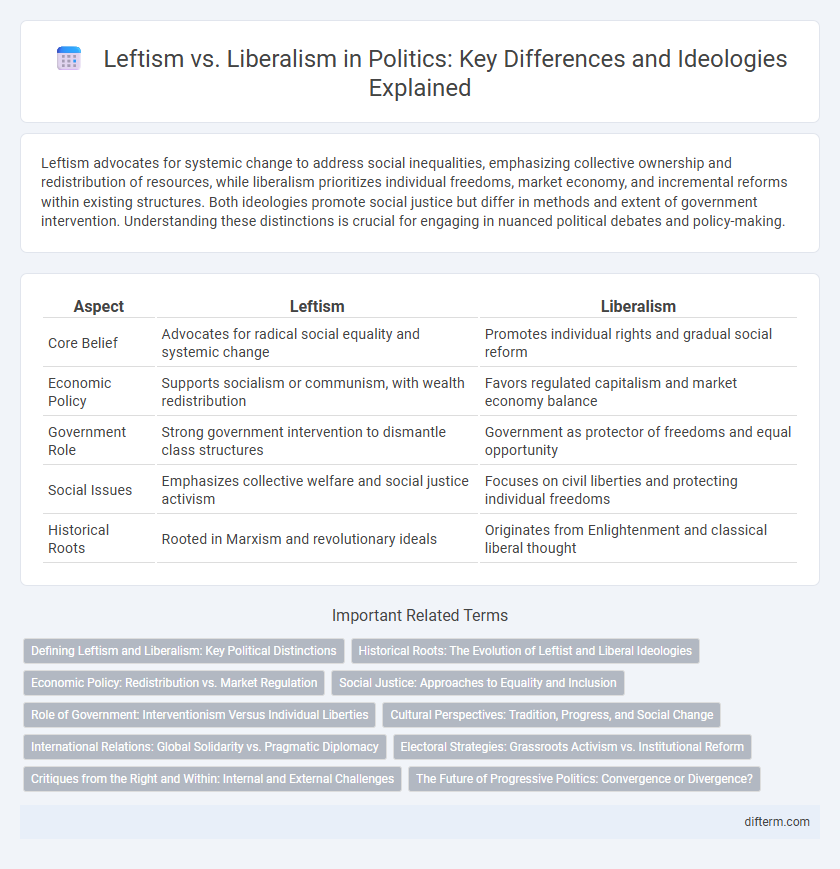Leftism advocates for systemic change to address social inequalities, emphasizing collective ownership and redistribution of resources, while liberalism prioritizes individual freedoms, market economy, and incremental reforms within existing structures. Both ideologies promote social justice but differ in methods and extent of government intervention. Understanding these distinctions is crucial for engaging in nuanced political debates and policy-making.
Table of Comparison
| Aspect | Leftism | Liberalism |
|---|---|---|
| Core Belief | Advocates for radical social equality and systemic change | Promotes individual rights and gradual social reform |
| Economic Policy | Supports socialism or communism, with wealth redistribution | Favors regulated capitalism and market economy balance |
| Government Role | Strong government intervention to dismantle class structures | Government as protector of freedoms and equal opportunity |
| Social Issues | Emphasizes collective welfare and social justice activism | Focuses on civil liberties and protecting individual freedoms |
| Historical Roots | Rooted in Marxism and revolutionary ideals | Originates from Enlightenment and classical liberal thought |
Defining Leftism and Liberalism: Key Political Distinctions
Leftism advocates for systemic social and economic equality, emphasizing collective ownership, wealth redistribution, and radical reforms to challenge capitalist structures. Liberalism prioritizes individual freedoms, market economy, and incremental social progress through reforms within existing political frameworks. Core political distinctions include leftism's focus on class struggle and anti-capitalism versus liberalism's support for private property and pluralistic democracy.
Historical Roots: The Evolution of Leftist and Liberal Ideologies
Leftism traces its roots to the French Revolution, advocating for radical social equality and collective ownership, while liberalism emerged from Enlightenment ideals emphasizing individual rights, private property, and limited government. Classical liberalism prioritized constitutionalism and free markets, whereas leftist ideologies evolved through Marxism and socialism into movements demanding wealth redistribution and social justice. The historical divergence reflects differing responses to industrialization and capitalism, with liberals supporting reform within the system and leftists pushing for systemic overhaul.
Economic Policy: Redistribution vs. Market Regulation
Leftism prioritizes wealth redistribution through progressive taxation and social welfare programs to reduce economic inequality and provide universal public services. Liberalism emphasizes market regulation aimed at ensuring fair competition, consumer protection, and correcting market failures while maintaining a largely capitalist economic framework. Policies in leftist economics often advocate for public ownership or control of key industries, contrasting with liberals' preference for regulated private enterprise driving economic growth.
Social Justice: Approaches to Equality and Inclusion
Leftism advocates for systemic changes to address social inequalities, emphasizing redistributive policies and collective action to achieve social justice. Liberalism prioritizes individual rights and equal opportunity, promoting inclusion through legal protections and anti-discrimination measures. Both ideologies seek equality, but leftism pushes for transformative structural reforms while liberalism focuses on reform within existing institutions.
Role of Government: Interventionism Versus Individual Liberties
Leftism advocates for robust government intervention to address social inequalities and provide extensive public services, emphasizing collective welfare over individual autonomy. Liberalism prioritizes protecting individual liberties and limiting government interference, championing free markets and personal choice as means to achieve social progress. The debate centers on balancing state power with personal freedom, where leftism leans toward systemic regulatory frameworks, and liberalism defends minimal state intrusion.
Cultural Perspectives: Tradition, Progress, and Social Change
Leftism emphasizes radical social change and challenges traditional cultural norms to promote equity and dismantle systemic oppression, whereas liberalism seeks to balance progress with the preservation of individual rights and existing institutions. Both ideologies support social progress, but leftism often advocates for more transformative reforms, while liberalism favors gradual adaptation within established frameworks. Debates around cultural identity, tradition, and reform highlight differing views on how societies should evolve and address historical inequalities.
International Relations: Global Solidarity vs. Pragmatic Diplomacy
Leftism in international relations emphasizes global solidarity, advocating for systemic change through collective action against imperialism and economic inequality. Liberalism prioritizes pragmatic diplomacy, seeking cooperative engagement through institutions like the United Nations to balance national interests with global stability. These contrasting approaches shape policy decisions on international aid, trade agreements, and conflict resolution, reflecting divergent visions of global governance.
Electoral Strategies: Grassroots Activism vs. Institutional Reform
Leftism emphasizes grassroots activism by mobilizing local communities and organizing protests to challenge systemic inequalities, often operating outside traditional political frameworks. Liberalism prioritizes institutional reform through electoral means, supporting policy changes within existing governmental structures to promote gradual social progress and protect individual rights. Both strategies aim to influence political outcomes but differ fundamentally in their methods and targets for achieving social change.
Critiques from the Right and Within: Internal and External Challenges
Critiques from the right often target leftism's perceived economic radicalism and threats to traditional social structures, contrasting it with liberalism's emphasis on individual freedoms and market economies. Internal challenges within leftist movements include debates over pragmatic reforms versus revolutionary change, causing fragmentation and weakening political cohesion. From the right, liberalism faces criticism for enabling cultural relativism and undermining national identity, while internal disputes question the balance between preserving civil liberties and enforcing social order.
The Future of Progressive Politics: Convergence or Divergence?
Leftism and liberalism continue to shape the future of progressive politics by highlighting distinct priorities: leftism emphasizes systemic change and economic equality, whereas liberalism focuses on individual rights and incremental reform. The convergence of both ideologies could enhance coalition-building for social justice and climate action, while their divergence risks fragmenting voter bases and weakening advocacy on issues like healthcare and workers' rights. Understanding these dynamics is crucial for policymakers and activists aiming to craft inclusive platforms that address inequality and democratic participation.
leftism vs liberalism Infographic

 difterm.com
difterm.com